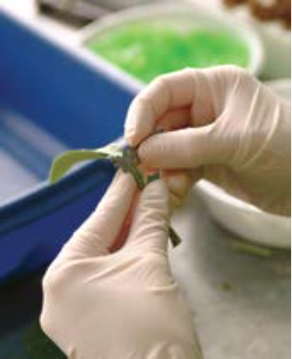Jul 19, 2017Seedless watermelons focus of grafting study
Some people love to eat a juicy, seedless watermelon for a tasty, refreshing snack during a hot, Florida summer day. University of Florida scientists have found a way to stave off potential diseases while retaining that flavor.
Consumers increasingly savor the convenience and taste of seedless watermelons, said Xin Zhao, a UF/IFAS associate professor of horticultural sciences and lead author of a new study examining rootstocks, flavor and texture of watermelons.
Many Florida growers produce seedless cultivars because that’s what consumers want, and it’s important to maintain the fruit’s yield and taste, as seedless cultivars might be more susceptible to fusarium wilt, a major soil-borne disease issue in Florida watermelon production, Zhao said.
For the study, UF/IFAS researchers grafted seedless watermelon onto squash rootstocks to ward off soil-borne diseases such as fusarium wilt. In plant grafting, scientists call the upper part of the plant the scion, while the lower part is the rootstock. In the case of vegetable grafting, a grafted plant comes from joining a vigorous rootstock plant – often with resistance or tolerance to certain soil-borne pathogens – with a scion plant with desirable aboveground traits.
Grafting is a useful tool to manage soil-borne diseases, but in this study, researchers were concerned that if they grafted watermelon onto squash rootstocks, they might reduce its fruit quality and taste. Overall, study results showed no loss in taste and major fruit quality attributes like total soluble solids and lycopene content, Zhao said. Consumers in UF taste panels confirmed the flavor remained largely consistent between grafted and non-grafted plant treatments under different production conditions.
Furthermore, said Zhao, compared with the non-grafted seedless watermelons, plants grafted onto the squash rootstocks exhibited a consistently higher level of flesh firmness.
“We are continuing our grafted watermelon research to optimize management of grafted watermelon production, maximize its full potential and seek answers to economic feasibility,” she said.
Still to come is a paper that specifically tells researchers whether they warded off fusarium wilt under high disease pressure, Zhao said. Grafting with selected rootstocks as a cultural practice is viewed as an integrated disease management tool in the toolbox for watermelon growers to consider when dealing with fusarium wilt “hot spots” in the field, she said. However, most squash rootstocks are generally more susceptible to root-knot nematodes, a potential challenge with using grafted plants. Other UF/IFAS researchers are tackling that issue.
Florida produces plenty of watermelons. In fact, according to a UF/IFAS Extension document, the Sunshine State ranked first nationally in watermelon production as of 2010, accounting for 18 percent of the total U.S. production, 23 percent of the U.S. crop’s total value, and 19 percent of the national watermelon acreage.
The new UF/IFAS study is published in the Journal of the Science of Food and Agriculture. The Florida Specialty Crop Block Grant Program funded the project.
– Brad Buck, University of Florida
Source: University of Florida















